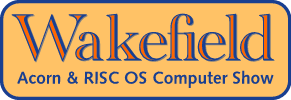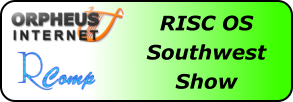I never knew the RiscPC tasted so good!
This year’s big RISC OS event in the North – the Wakefield Show – took place on 26th April, so it is once again time to put pen to paper fingers to keyboard, and write about it for the benefit of those who were unable to attend. As usual, the show took place in the Cedar Court Hotel, Denby Dale Road, just off junction 39 of the M1 – the same venue in which it started some eighteen years ago (making this the nineteenth show), and to which it returned several years ago.
Occupying the Oak/Hawthorne and Cypress Suites, opened up through an adjoining door into one larger space, the show’s organisers took the approach of arranging the exhibitors so that the smaller of the rooms was largely occupied by the retro enthusiasts, and the other was largely occupied by those more focused on current and future technologies.
Entry into the show was via the former of these, so I’ll cover that room first, and then the other – and I’ll opt for a figure-8 approach to wandering around the show; going anti-clockwise through the Oak/Hawthorne Suite, then crossing over at the joining door and heading clockwise around the Cypress Suite. That’ll confound anyone who says I’m formulaic in my approach to these show reports!
As I said above, this room was largely occupied by retro-based exhibitors, along with the charity stand and the organisers’ own stand, which is the first one encountered in this virtual tour of the show. The Wakefield RISC OS Computer Club did a splendid job of organising the show, as ever, and on offer on their stand were their networking guides, the latest edition of their back-catalogue CDs, and a 50% discount on the first year’s membership for those joining at the show. WROCC were also running a prize draw to win a Raspberry Pi, complete with a case, a NOOBS card, a power supply and a book by Bruce Smith entitled Raspberry Pi RISC OS System Programming Revealed, which was won by Kali Prajita from Huddersfield.
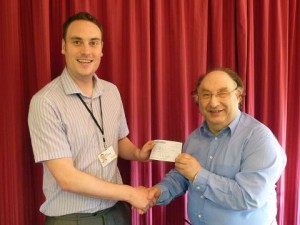
Proceeds from the draw went to the Wakefield Hospice, for which the charity stand, found immediately after WROCC, was also raising money. The amount raised this year was £899, with an additional £30 raised from Steve Fryatt’s sales. To date, the club have managed to raise over £20,000 for the hospice – which is a very impressive amount of money.
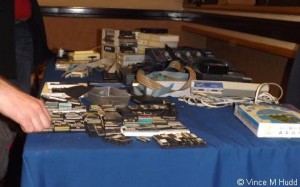
Next was Jess Rowbottom, with “Jessicat’s 8-bit Garage Sale” – aiming to reduce her collection of old Acorn 8-bit (and some 32-bit) equipment, ranging small items such as floppy discs to larger items such as computers (from an Atom right up to a RiscPC 700), and at the same time proving that CJE Micro’s don’t hold the patent on getting a large amount of stuff into a car in order to get it to shows – Jess apparently brought her collection to the show in a Fiat Punto.
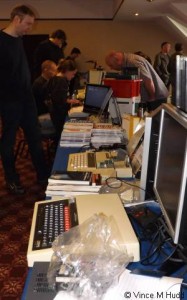
After Jess, Retro Hardware were set up with a range of Acorn computers, and projects for them, including new versions of some old products, such as the Advanced ROM Adaptor, which provided EPROM expansion capabilities for the Acorn Electron, and an Advanced Battery-Backed RAM and an Advanced Tube Interface, with a 6502 second processor, both also for the Electron. Retro Hardware had these available as a kit or a built unit, and both in standard or low-profile form, the latter of which can fit into a standard Acorn cartridge. One of the computers featured on this table was a BBC Master in an ugly grey case – apparently the Olivetti version of Acorn’s Master Compact.
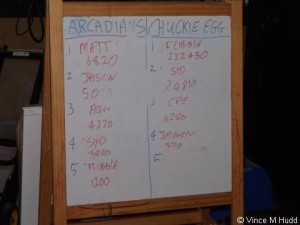
Complementing Retro Hardware, the next stand was occupied by Retro Software, with 8-bit games available to play – and if you consider anything retro to be lo-tech compared with modern hardware and software, the Retro Software stand took this to a new extreme by featuring an ultra-lo-tech high score table; tabs were being kept on who had the highest scores in Arcadians and Chuckie Egg by writing them on a whiteboard! (I gather this was a high score competition being run throughout the day, though I don’t know what the final results were – nor if the winner walked away with anything other than a feeling of pride!)
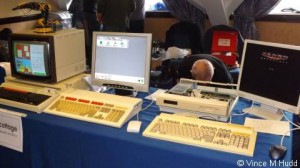
FlaxCottage was next, exhibiting educational software, and a robot arm connected by USB to a DataCentre, in turn connected to a BBC Micro, and controlled by typing in commands in a home-brewed language, as well as explaining some aspects of cracking software protection – which may be necessary for the purposes of preserving that software, and continuing to access and use it when the original medium, such as cassette tape, becomes hard to read (perhaps through wear and tear of the medium itself, or the hardware to read it), although – having transferred a lot of old cassette-based games to disc myself back in the 8-bit days (to make loading them much faster) – I have to admit it can also just be fun.
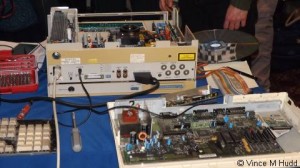
Jason Flynn had the final stand in the Oak/Hawthorne Suite, on which he had a ‘complete repair suite’ – so visitors could bring along their ailing hardware in the hope it could be fixed. Apparently, during the day he repaired several laser disc players from BBC Domesday systems.
I should probably point out that the above is based on the exhibitors as listed, but there was a small amount of stand-sharing amongst the retro-exhibitors, with the odd (no, not that sort of odd – well, okay, maybe a little!) additional exhibitor taking up one end of a table here and there.
The first stand in the Cypress Suite was home to MW Software, where Martin Wuerthner was talking to people about the range of software he produces, such as Artworks and EasiWriter, but didn’t have anything new for the show, however, still being a little busy with a young child. Martin also gave the first theatre talk of the day, though it was somewhat unplanned, as his comments reveal at the start of the talk!
Martin Wuerthner’s theatre talk
After Martin, Sine Nomine Software had a very busy stand, because Matthew and Hilary Phillips were launching a brand new product, which generated a lot of interest. RiscOSM is a mapping application that uses, as its source, data from Open Street Map, and was being sold for £20 at the show, on a CD containing data covering the British Isles and the Netherlands – and which was the subject of the penultimate talk of the day, given by Matthew.
Matthew Phillips’ theatre talk
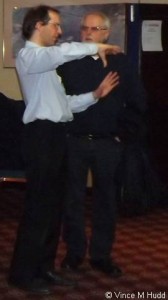
Prompted by a comment made on Twitter when I posted Sine Nomine’s announcement about the software in the run up to the show, I questioned them about the licence under which the data is released. The comment was to raise the point that the Open Street Map data is provided by a Creative Commons Attribution-ShareAlike licence (or CC-BY-SA for short) which means the data can be copied and distributed, as well as adapted and used in another product, even a commercial one, but the results – in this case the map data – must be provided under the same CC-BY-SA licence. The Phillips’ confirmed that this was the case; the map data isn’t the product, as such, the software is. The map data is there because the software isn’t much use without some data to work with!
That data, they explained, had to be converted in the interests of efficiency; due to the way the Open Street Map data is structured, searching through that data to render a map on the fly would be very slow. The approach they’ve adopted is to convert the data – or rather, restructure it – to keep together all the data relating to a particular area, and within that area it is layered, so that when rendering the map, the deeper the layer, the more detailed the map that is rendered. The eventual plan is to release the software that performs the conversion of the Open Street Map data, so that users can download more up to date maps when they choose by fetching the raw data (since that data is being contributed to and updated all the time).
After Sine Nomine’s stand came the Organizer stand, where Oraganizer-on-a-Stick was being sold by Cut-Me-Own-Throat-Dibbler Nigel Willmott and Martin Avison. Sadly, this wasn’t a new version – but that may be because Martin has been a little busy with other software; he’s been working on Pluto recently, and has also updated Keystroke.
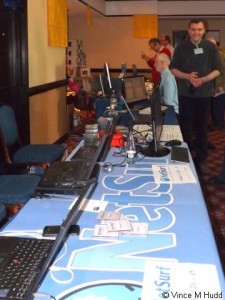
Next up, the NetSurf team had a new version of the lean, mean browser available. Version 3.1 features much faster CSS selection performance, faster start-up time, changes to the look and feel of the bookmarks, history and cookie manager, as well as improvements to the way options are handled. As ever, this is available as a free download, but CDs were available at the show for a fiver, and buying one helps cover the costs involved in the project.
Immediately after the NetSurf team, Steve Fryatt was aiming to help users keep a track of their personal finances with CashBook, and find anything and everything on their RISC OS computers with Locate2, and do other stuff with other software. Unfortunately, though, Steve hasn’t had a great deal of time to concentrate on his software, so there were no new versions.
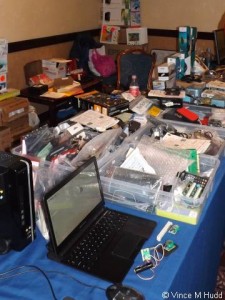
Extending from Steve’s desk to the end of the hall, Chris Evans and Andrew Conroy had, as usual, brought along a large amount of kit to sell visitors on the CJE Micro’s stand – and it seems they’ve decided to stop breaking the laws of physics and abandon the use of a TARDIS; this time they came in a van, allowing them to bring more and, potentially, take more home with them: Observant readers will have noted recent announcements from CJE requesting old hardware and software and, separately, old laptops, even ones that are incomplete and not working. The first of these was simply a run of the mill request, because CJE recognise that some people are loathe to just scrap old gear, even if they think it’s worthless, but may need to get rid of it to free up space – and CJE can often find good homes for old gear (though, it seems, they do occasionally end up throwing things out themselves).
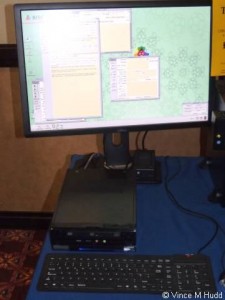
The second of those announcements, though, is more interesting. The origins of this lie with the new Raspberry Pi Compute Module from the Raspberry Pi Foundation. (This hasn’t been properly mentioned on RISCOSitory so, briefly, it’s the BCM2835 processor as used on a Pi, along with 512MB RAM and a 4GB eMMC flash device, together on a small board with a standard DDR2 SODIMM connector, designed for embedding.) CJE are hoping to be able to build on this and produce a computer that fits more readily into standard cases than devices like the Raspberry Pi itself – possibly a number of different systems based on different standard motherboard sizes – and an obvious contender is a laptop. There are two different plans here, and the request for old laptops relates to their ‘longer term’ plan; they want to study a range of different laptop cases with the aim of producing a board that would be suitable for use in a “DIY hardware hacker’s laptop” with the GPIO connection brought out to where the optical drive normally sits.
Chris Evans’ theatre talk
Turning away from CJE, Richard Keefe had the table at the end of the hall, where he was talking about his work on Impression-X; an updated and (eventually) 32-bit version of Impression. Richard told me that he now has a 26-bit version of the software running, subject to two bugs he still needs to address, and is looking for beta testers. With the software at that stage, I pressed him for possible release dates and prices and – though it should be stressed these are far from definite – he suggested £50 might be a reasonable price for an upgrade from previous versions to the latest 26-bit version, and £100 for the full version. The 32-bit version, he says, could possibly appear in 2015 – but couldn’t emphasise the word ‘possibly’ enough. Richard also pointed out that there are now three mailing lists supporting impression:
- impression-bugs@freelists.org – for bug reports
- impression-info@freelists.org – for updates and information (no user posts)
- impression-x@freelists.org – for feature requests and discussion
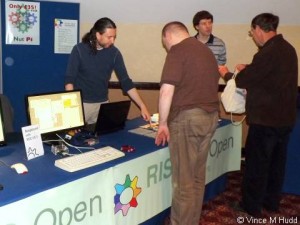
Occupying the usual corner of the hall at Wakefield – which I’m now tempted to start calling ROOL Corner – RISC OS Open were next, where Steve Revill and Rob Sprowson were selling the Nut Pi SD cards, Emulate and Native USB sticks, and so on, as well as answering people’s questions and demonstrating the latest version of RISC OS – including a version running on the new Raspberry Pi Compute module which, being so new, was something of a coup to have at a RISC OS show.
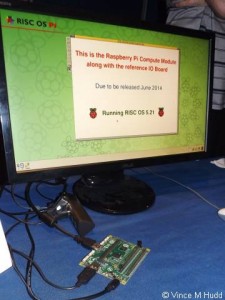
Steve also gave one of the day’s theatre talks, where he covered a lot of RISC OS Open background, from the history leading up to the company’s formation, to what the various people involved do, and so on. Exposure was a particular area Steve talked about, discussing the work involved in keeping the public informed, through various means, about what is going on with RISC OS developments. Some very interesting factoids Steve revealed include that in the couple of years since its release, over £16,000 worth of Nut Pi cards have been sold – which back of envelope maths suggest is over 450 cards, assuming Steve was talking about the net price – and that they’ve sold over 500 RISC OS Pi cards; that’s significantly more potential RISC OS users out there than who took part in RISCOSitory’s first annual awards poll and survey!
Steve Revill’s theatre talk
Christopher Dewhurst was manning the next stand, promoting the on-off-on-off-under new management PDF magazine, Drag ‘n Drop. The latest issue appeared just over a week before the show, and we can expect the next issue to be appear late June or early July, so just preceding this year’s Midlands Show, which is scheduled for 12th July. Christopher was also selling CD-ROMs containing 55 BBC Micro books for £10, and all the back issues of the magazine, up to and including the latest (volume 5 issue 3) on a memory stick, also for £10.
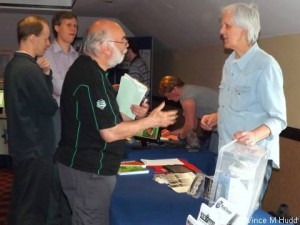
Magazines were available from the next stand, as well, where Jim Nagel was representing Archive Magazine – the latest issue of which had also come out a week or so before the show. Jim had a selection of old copies for people to take away, and was taking new subscriptions and renewals, as well as selling the handy Archive magazine DVD.

The Soft Rock Software stand was next, where I am was talking to people about WebChange as usual (and making the usual excuses for not finishing the manual), and also the new (not yet released) version of WaitUntil, a small program that allows multitasking pauses to be put in Obey files, and letting people play my old games (as part of the celebration of this year being Soft Rock Software’s 25th birthday). A few people played with Quicksand on the Pi but, of the old games, only Floopy was played, and ROUGOL‘s Bryan Hogan again got though a few levels, and I got through a few more – and this time I noted down the passwords for the levels we reached. I also had something brand-spanking new on my stand, which I’m sure nobody expected: A new poster – advertising an even newer poster, no less, which is expected to appear in 2015! Ooh!
RISC OS-friendly ISP, Orpheus Internet had the penultimate stand, where Richard Brown was on hand to provide tech and sales support to any RISC OS customers needing it, as well as to discuss people’s requirements and future projects – including a possible cloud solution aimed directly at RISC OS computers and users. Annoyingly, I completely forgot to ask Richard about this, so I shall make a point of quizzing him at the next show.
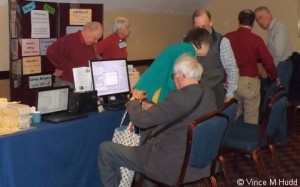
The final stand belonged to R-Comp, where Andrew Rawnsley and the team were, as ever, demonstrating a wide range of hardware and software – and this year were launching a new genealogy application, DPGenealogy. The package is based on the DataPower database engine – hence the name – and complements their existing Genealogy Records software, which itself now runs on RISC OS and Windows, giving users the ability to use the software on a laptop ‘in the field’ and bring it home for incorporating in DPGenealogy. Andrew talked about the software in more detail in his theatre talk.
Andrew Rawnsley’s theatre talk
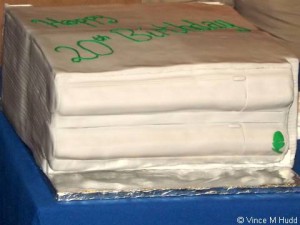
The original floor plan for the show had my stand between the Orpheus Internet and R-Comp stands, but Richard Brown and I swapped places for a very good reason. The 15th April, 2014 marked the 20th birthday of the RiscPC, and between them, Richard and Andrew had arranged something for the show to commemorate that birthday: A RiscPC-shaped birthday cake, made by Richard’s wife. During the afternoon, everyone gathered to wish the iconic computer a happy birthday, and to have a slice (or three) of the cake – which, despite taking the form of a two-slice RiscPC, turned out to provide many, many more slices than that.
The RiscPC birthday cake being cut
And jolly good it tasted, too.
Now, I wonder if there will be a cake at next year’s show? If the show goes ahead, and I’ve no doubt it will, the most likely date based on the last few years would be 25th April, which would be just one day out from a thirtieth birthday that should be very important to all RISC OS users: Although it was the ARM2 that first ran RISC OS, its predecessor, the ARM1, ran its first piece of code on 26th April, 1985.
As well as the videos and photographs included above, photographs have also been made available by Steve Fryatt, Peter Howkins, JG Harston, and ‘BeebMaster‘ – and here are a few more from me:
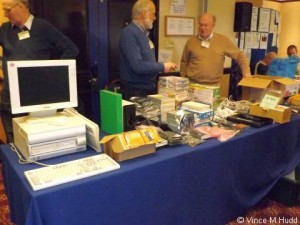
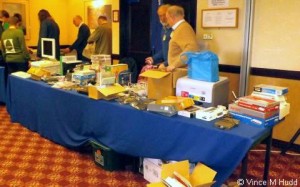
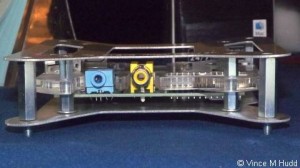
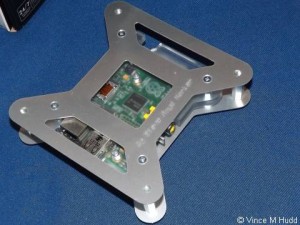
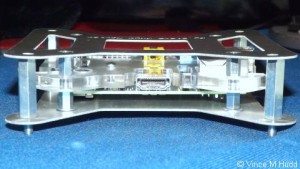
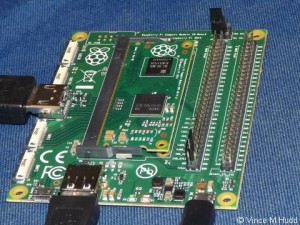
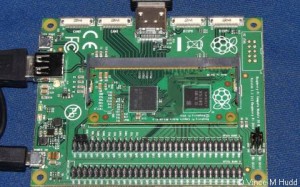
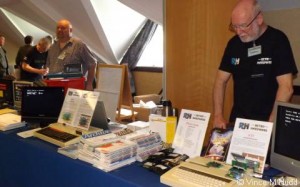
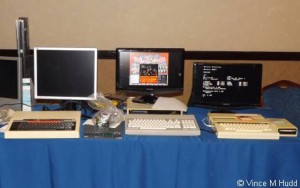
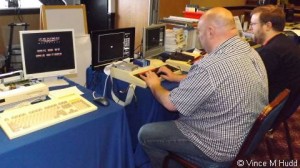
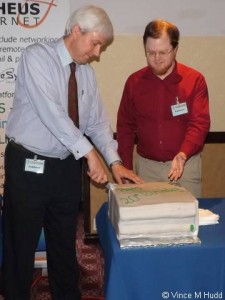
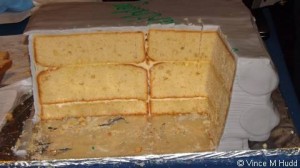
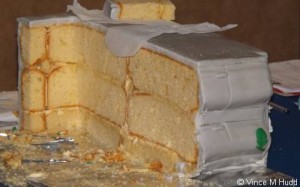
And in a stop the press moment, I’ve just found another video taken at the show, of someone playing Thrust on a BBC Micro, on YouTube:
Another video I’d hoped to include, but which has yet to appear, is Steve Revill’s time lapse of the event; his camera was set up in ROOL Corner, but he has yet to put the results online, so I’ll include it in a future post.
So that was Wakefield 2014 – roll on Wakefield 2015. (And, er, Midlands and London 2014, as well!)


